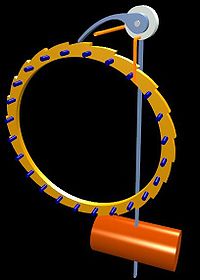
Galileo's escapement
Encyclopedia

Escapement
In mechanical watches and clocks, an escapement is a device that transfers energy to the timekeeping element and enables counting the number of oscillations of the timekeeping element...
, invented by Galileo Galilei
Galileo Galilei
Galileo Galilei , was an Italian physicist, mathematician, astronomer, and philosopher who played a major role in the Scientific Revolution. His achievements include improvements to the telescope and consequent astronomical observations and support for Copernicanism...
.
While observing, and timing with his pulse, the swinging of lamps in the cathedral at Pisa, Galileo realized that their apparent isochronicity could be used for timekeeping. We now know that the pendulum
Pendulum
A pendulum is a weight suspended from a pivot so that it can swing freely. When a pendulum is displaced from its resting equilibrium position, it is subject to a restoring force due to gravity that will accelerate it back toward the equilibrium position...
is approximately isochronous
Isochronous
Isochronous : From Greek iso, equal + chronos, time. It literally means regularly, or at equal time intervals. In general English language, it refers to something that occurs at a regular interval, of the same duration; as opposed to synchronous which refers to more than one thing happening at the...
only for small amplitudes, but it was nonetheless a vast improvement on the crude verge escapement
Verge escapement
The verge escapement is the earliest known type of mechanical escapement, the mechanism in a mechanical clock that controls its rate by advancing the gear train at regular intervals or 'ticks'. Its origin is unknown. Verge escapements were used from the 14th century until about 1800 in clocks...
s of the day, keeping time to perhaps 15 minutes in 24 hours.

